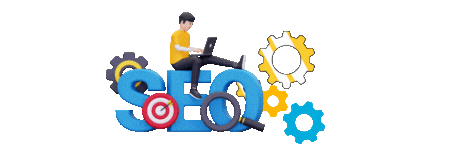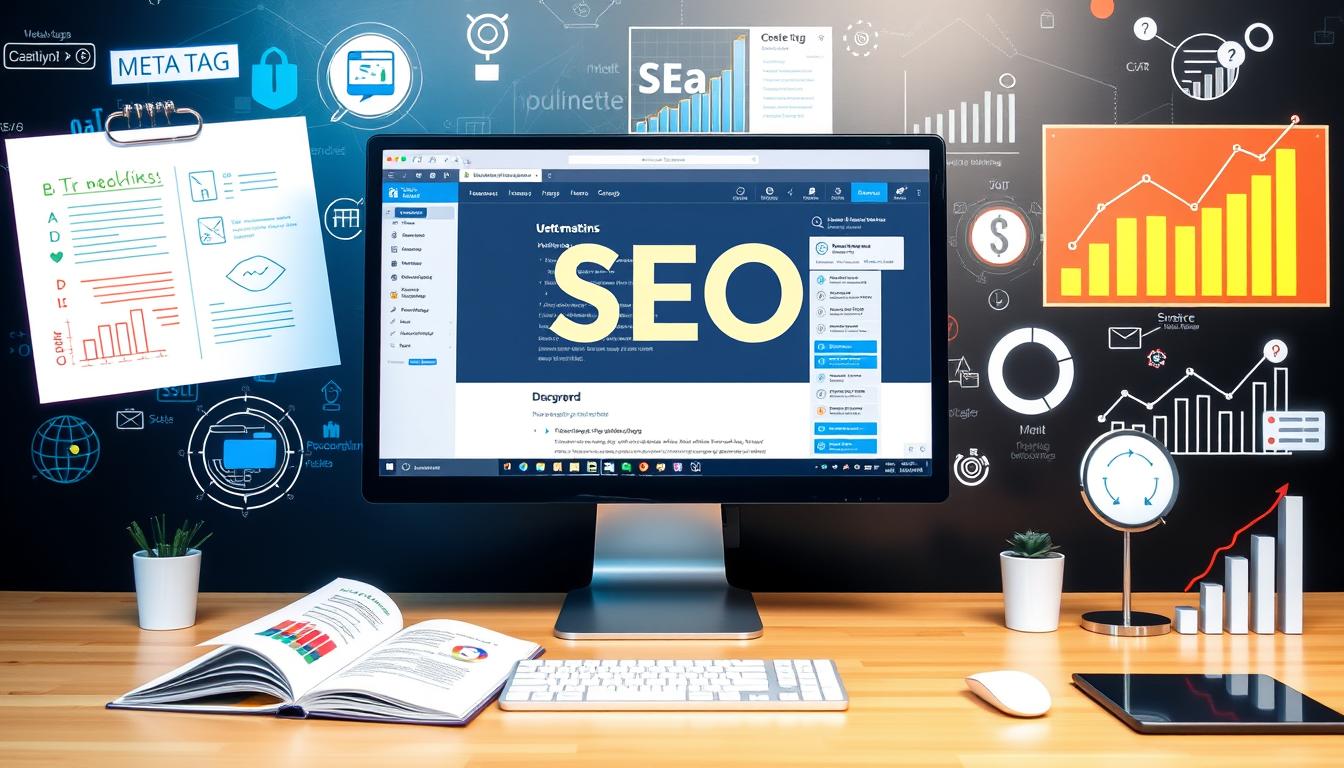In today’s digital world, making your website better for search engines is key. This helps you show up more in Google’s search results. By getting good at on-page SEO, you can make your site rank higher, get more visitors, and turn them into customers.
This guide will show you how to make your website better. We’ll talk about things like title tags, meta descriptions, and how to link your pages well. These are important steps to help you beat your competitors online.
Key Takeaways
- On-page SEO is a vital part of a good digital marketing plan.
- Improving your title tags, meta descriptions, and header tags can help you show up more in search results.
- Having a site that’s easy to use and links well can make your site more trusted and ranked higher.
- It’s important to make sure your site works well on phones and meets Core Web Vitals for a good user experience.
- Keeping an eye on and updating your SEO is key to keeping and improving your rankings over time.
Understanding the Fundamentals of ON PAGE SEO
Exploring digital marketing, we find on-page SEO is key. It boosts website traffic and Google rankings. It’s the base of a good SEO plan. Knowing on-page SEO basics helps businesses get seen online more.
Key Components of Modern On-Page Optimization
Today’s digital world needs many on-page SEO parts. These include title tags, meta descriptions, and image optimization. Each part helps make your site friendly for search engines and users.
Why On-Page SEO Matters in 2024
In the future, on-page SEO will still be very important. Search engines will value user experience and content more. Learning on-page SEO helps businesses attract more website traffic.
The Role of User Experience in SEO
On-page SEO optimization is not just for search engines. It’s also about making users happy. Search engines like sites that are easy to use and have good content. This makes your on-page SEO better and keeps customers coming back.
“Optimizing your website’s on-page SEO is like building a foundation for a skyscraper – it’s the essential groundwork that supports everything above it.”
Essential Elements of Title Tag Optimization
The title tag is very important in on-page SEO. It’s in the head section of a web page. It helps search engines and users know what your site is about.
By making good and SEO-friendly title tags, we can get more people to visit our pages. This can help us rank higher in search engines.
To make your title tags work well, here are some key things to think about:
- Incorporate Keywords Strategically: Keywords in your title tags help search engines know what your page is about. But, make sure your titles are easy to read and not just full of keywords.
- Optimal Length: Keep your title tags between 50 and 60 characters. This lets you share your message without getting cut off in search results.
- Unique and Distinct Titles: Each page should have its own title tag that shows what it’s about. Don’t use the same title for different pages. This can hurt your search engine ranking and how users feel about your site.
- Compelling and Engaging: Your title tags should grab users’ attention. Use words that make people want to click and read more. Make your titles clear and to the point.
By focusing on these key points, you can improve your on-page SEO. This will help more people find and visit your website. Remember, your title tag is the first thing users see, so make it good!
| Title Tag Element | Best Practices |
|---|---|
| Keyword Inclusion | Include relevant keywords, but avoid keyword stuffing |
| Length | Aim for 50-60 characters |
| Uniqueness | Create unique titles for each page |
| Engagement | Use power words and emotional triggers to captivate users |
Crafting Meta Descriptions That Drive Clicks
Meta descriptions are key in SEO. They help your website get more visitors. These short texts under your page titles in search results can make people click on your site. Learning to write great meta descriptions can boost your website’s traffic.
Best Practices for Meta Description Writing
Writing good meta descriptions is all about balance. Here are some tips:
- Keep your meta description between 150-160 characters to fit in search results.
- Use your main meta tags and SEO optimization keywords to make it relevant.
- Write in a way that makes people want to click on your site.
- Show what makes your page special or useful.
- Write naturally, so it feels like you’re talking directly to your audience.
Common Meta Description Mistakes to Avoid
There are mistakes to avoid when writing meta descriptions. These can hurt your website traffic. Here are some common ones:
- Don’t use the same meta description for all pages. It should be unique.
- Avoid too many keywords. It should read naturally.
- Make sure your meta description matches what’s on your page.
- Don’t forget about mobile users. Your description should look good on all devices.
Using Emotional Triggers in Meta Descriptions
To get more clicks, use emotional triggers in your meta descriptions. This can make people feel curious or excited. Here are some ideas:
“Discover the secret to boosting your website traffic overnight!”
The secret to great meta descriptions is to mix useful info with emotional appeal. By doing this, you can attract more visitors to your site.
Header Tags and Content Structure Strategy
Header tags and content structure are key for on-page SEO. They help search engines understand and rank your pages. Using H1, H2, and H3 tags makes your content clear and easy to follow.
The H1 tag is for the main title of your page. It should briefly tell what your page is about. Then, use H2 tags for main sections or subtopics. This makes your page easy to read and understand.
For more detail, use H3 tags in each H2 section. They help you go deeper into topics or add extra information. This keeps your content organized and easy to find what you need.

Using header tags is good for both search engines and your visitors. A well-organized page keeps people interested and helps them become loyal customers or subscribers.
When you work on your on-page content, remember the role of header tags and structure. Mastering this part of SEO can help you get higher Google rankings and more visitors to your site.
Optimizing Image Elements for Better Rankings
Optimizing images is key in on-page SEO. It helps your website get seen more and get more visitors. Using images wisely can really help your SEO.
Image Alt Text Best Practices
Alt text is important for search engines and people with disabilities. Make it short and clear, showing what the image is. Use the right keywords but don’t stuff them.
Image Compression and Loading Speed
Big images slow down your site. Use compression to make them smaller but still look good. This makes your site fast and tells search engines you care about speed.
Using Strategic Image File Names
Good image file names help your SEO too. Use names that tell what’s in the image and include keywords. It’s a simple way to help your images show up better in searches.
Learning to optimize images well can really help your SEO. It brings more people to your site.
Creating SEO-Friendly URLs and Site Architecture
Digital marketers know how important on-page SEO is. It helps your website get more visitors and rank higher on Google. But, many forget about the website’s URL structure and site architecture.
Making your URLs SEO-friendly is key. It helps users and search engines find your content easily. Here are some tips:
- Use clear, descriptive keywords in your URLs instead of random numbers and letters.
- Keep URLs short and simple, without extra characters or parameters.
- Organize your site’s content in a clear, logical way, with easy-to-follow categories and subcategories.
- Make sure your URL structure is the same everywhere on your website. This helps both users and search engines.
Following these tips can boost your website’s SEO optimization. It also makes your site better for users, leading to more website traffic and better rankings.
A well-organized website with SEO-friendly URLs is crucial for success. By improving your site’s architecture, you’ll see better results in search engine rankings.

“A well-structured website with SEO-friendly URLs is a key component of a successful on-page SEO strategy.”
Internal Linking Strategies for Better Rankings
Improving your website’s internal links is key for on-page SEO. By linking your pages smartly, we can boost your site’s authority. This helps your site rank better in search engines. We’ll look at good anchor text, where to place links, and content silos.
Anchor Text Best Practices
The text in your internal links is very important. It tells search engines what the link is about. Here’s how to make it better:
- Use clear, keyword-rich text that matches the page’s content
- Avoid simple phrases like “click here” or “learn more”
- Vary your anchor text to avoid too much of the same thing
- Make sure the text fits naturally with the content around it
Strategic Link Placement
Where you put your links matters a lot. Don’t just scatter them everywhere. Try these smart ways to place links:
- Put links where they’re most useful and interesting to readers
- Use “related content” sections to link similar pages
- Place links in your site’s navigation, footer, or sidebar for easy finding
Building Content Silos
Grouping your content into content silos helps SEO a lot. It makes your site more organized and easier for search engines to understand. Here’s how to do it:
- Find your main content categories and subcategories
- Link pages in the same silo together, but not across different ones
- Make sure each silo has a clear theme and order
- Use URLs that show your content silo structure
Using these internal linking strategies can make your website’s SEO much better. This can help your site rank higher in search results.
Mobile Optimization and Core Web Vitals
In today’s world, mobile devices are key. We need to make our website work well on phones and tablets. It should look good and work fast.
Google’s Core Web Vitals help us check our website’s performance. They look at how fast our site loads and how smooth it is. Meeting these standards shows Google our site is great on mobile. This helps our SEO and brings more visitors.
To improve our site, we’ll make it load faster and feel smoother. We’ll use tricks like compressing images and making our code efficient. This way, our website will be a joy to use on mobile devices.

